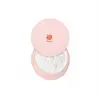Skinfood Peach Cotton Multi Finish Powder Versus Givenchy Prisme Libre Setting and Finishing Loose Powder
What's inside
What's inside
 Key Ingredients
Key Ingredients

 Benefits
Benefits

 Concerns
Concerns

 Ingredients Side-by-side
Ingredients Side-by-side

Silica
AbrasiveTalc
AbrasiveBoron Nitride
AbsorbentDimethicone
EmollientPhenoxyethanol
PreservativeSodium Dehydroacetate
PreservativePolydiethylsiloxane
EmollientSilk Powder
Skin ConditioningAlcohol
AntimicrobialParfum
MaskingCalamine
AbsorbentPrunus Persica Fruit Extract
AbrasiveButylene Glycol
HumectantArgania Spinosa Kernel Oil
EmollientZingiber Officinale Root Oil
MaskingEnantia Chlorantha Bark Extract
Skin ConditioningBeta-Sitosterol
Emulsion StabilisingSerenoa Serrulata Fruit Extract
Skin ConditioningTocopherol
AntioxidantOleanolic Acid
Skin ConditioningSilica, Talc, Boron Nitride, Dimethicone, Phenoxyethanol, Sodium Dehydroacetate, Polydiethylsiloxane, Silk Powder, Alcohol, Parfum, Calamine, Prunus Persica Fruit Extract, Butylene Glycol, Argania Spinosa Kernel Oil, Zingiber Officinale Root Oil, Enantia Chlorantha Bark Extract, Beta-Sitosterol, Serenoa Serrulata Fruit Extract, Tocopherol, Oleanolic Acid
Talc
AbrasiveSynthetic Fluorphlogopite
Silica
AbrasiveDimethicone
EmollientCaprylyl Glycol
EmollientPentylene Glycol
Skin ConditioningPhenyl Trimethicone
Skin ConditioningHdi/Trimethylol Hexyllactone Crosspolymer
Sodium Dehydroacetate
PreservativeDiisostearyl Malate
EmollientOctyldodecyl Stearoyl Stearate
EmollientTocopheryl Acetate
AntioxidantParfum
MaskingSorbitan Sesquioleate
EmulsifyingGeraniol
PerfumingBHT
AntioxidantTocopherol
AntioxidantCI 77491
Cosmetic ColorantCI 77288
Cosmetic ColorantCI 19140
Cosmetic ColorantCI 77007
Cosmetic ColorantCI 77742
Cosmetic ColorantCI 77891
Cosmetic ColorantTalc, Synthetic Fluorphlogopite, Silica, Dimethicone, Caprylyl Glycol, Pentylene Glycol, Phenyl Trimethicone, Hdi/Trimethylol Hexyllactone Crosspolymer, Sodium Dehydroacetate, Diisostearyl Malate, Octyldodecyl Stearoyl Stearate, Tocopheryl Acetate, Parfum, Sorbitan Sesquioleate, Geraniol, BHT, Tocopherol, CI 77491, CI 77288, CI 19140, CI 77007, CI 77742, CI 77891
 Reviews
Reviews

Ingredients Explained
These ingredients are found in both products.
Ingredients higher up in an ingredient list are typically present in a larger amount.
Dimethicone is a type of synthetic silicone created from natural materials such as quartz.
What it does:
Dimethicone comes in different viscosities:
Depending on the viscosity, dimethicone has different properties.
Ingredients lists don't always show which type is used, so we recommend reaching out to the brand if you have questions about the viscosity.
This ingredient is unlikely to cause irritation because it does not get absorbed into skin. However, people with silicone allergies should be careful about using this ingredient.
Note: Dimethicone may contribute to pilling. This is because it is not oil or water soluble, so pilling may occur when layered with products. When mixed with heavy oils in a formula, the outcome is also quite greasy.
Learn more about DimethiconeParfum is a catch-all term for an ingredient or more that is used to give a scent to products.
Also called "fragrance", this ingredient can be a blend of hundreds of chemicals or plant oils. This means every product with "fragrance" or "parfum" in the ingredients list is a different mixture.
For instance, Habanolide is a proprietary trade name for a specific aroma chemical. When used as a fragrance ingredient in cosmetics, most aroma chemicals fall under the broad labeling category of “FRAGRANCE” or “PARFUM” according to EU and US regulations.
The term 'parfum' or 'fragrance' is not regulated in many countries. In many cases, it is up to the brand to define this term.
For instance, many brands choose to label themselves as "fragrance-free" because they are not using synthetic fragrances. However, their products may still contain ingredients such as essential oils that are considered a fragrance by INCI standards.
One example is Calendula flower extract. Calendula is an essential oil that still imparts a scent or 'fragrance'.
Depending on the blend, the ingredients in the mixture can cause allergies and sensitivities on the skin. Some ingredients that are known EU allergens include linalool and citronellol.
Parfum can also be used to mask or cover an unpleasant scent.
The bottom line is: not all fragrances/parfum/ingredients are created equally. If you are worried about fragrances, we recommend taking a closer look at an ingredient. And of course, we always recommend speaking with a professional.
Learn more about ParfumSilica, also known as silicon dioxide, is a naturally occurring mineral. It is used as a fine, spherical, and porous powder in cosmetics.
Though it has exfoliant properties, the function of silica varies depending on the product.
The unique structure of silica enhances the spreadability and adds smoothness, making it a great texture enhancer.
It is also used as an active carrier, emulsifier, and mattifier due to its ability to absorb excess oil.
In some products, tiny microneedles called spicules are made from silica or hydrolyzed sponge. When you rub them in, they lightly polish away dead skin layers and enhance the penetration of active ingredients.
Learn more about SilicaThis ingredient is a preservative with antimicrobial properties. It is the sodium salt of dehydroacetic acid.
It is especially effective at preventing bacterial and fungal growth in low concentrations.
Talc is a clay mineral. It helps absorb moisture and improve the texture of products. Like other types of clay, Talc can have a slight exfoliating effect on skin. Talc can be added to increase the volume of products.
Some Baby powders are made by combining talc with corn starch. The word "talc" comes from Latin and originates from Arabic. Talc is a mineral commonly found throughout the world.
If you have any concerns about using talc, we recommend checking out the FDA's official page.
Learn more about TalcTocopherol (also known as Vitamin E) is a common antioxidant used to help protect the skin from free-radicals and strengthen the skin barrier. It's also fat soluble - this means our skin is great at absorbing it.
Vitamin E also helps keep your natural skin lipids healthy. Your lipid skin barrier naturally consists of lipids, ceramides, and fatty acids. Vitamin E offers extra protection for your skin’s lipid barrier, keeping your skin healthy and nourished.
Another benefit is a bit of UV protection. Vitamin E helps reduce the damage caused by UVB rays. (It should not replace your sunscreen). Combining it with Vitamin C can decrease sunburned cells and hyperpigmentation after UV exposure.
You might have noticed Vitamin E + C often paired together. This is because it is great at stabilizing Vitamin C. Using the two together helps increase the effectiveness of both ingredients.
There are often claims that Vitamin E can reduce/prevent scarring, but these claims haven't been confirmed by scientific research.
Learn more about Tocopherol